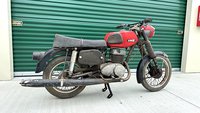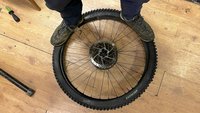
Product Intro/Review
Introducing PNW Range Composite Pedals
If you missed the release of PNW's original Loam pedal in aluminum, it was way back in January. I have been riding them since that time and my initial impressions hold true; they have good grip, an excellent bearing selection and configuration has kept them spinning smoothly, and their diminutive thickness (14mm at the leading and trailing edges including pins have kept them from egregiously snagging roots and rocks.

I've only had one ride on the PNW Range Composite pedals and I appreciated the grip while have no issues with clearance or anything else. Photo - Trevor Hansen
The bearing configuration is similar here, but the inboard bearing on the Loam version is too large in diameter to fit inside the pedal body so it's next to the pedal, pressed up against the crank arm. They have the same shape (despite the Ranges being 2mm thicker and lighter @ 398 g a pair vs. 445 g claimed), similar bearings and pins, and equivalent grip. The difference however is that you can get two pairs of the composite version for the cost of the already reasonably-priced aluminum model.

The Range pedal in composite is much cheaper than the Loam version in aluminum, but composite has its advantages.
PNW Range Aluminum Pedal Features (from PNW)
- Weight: 390 Grams (pair)
- Pedal Body Material: Glass fiber-reinforced nylon composite
- Axle: Chromoly steel
- Cartridge bearing, roller bearing and inboard bushing
- Platform size: 115mm x 108mm
- 22 steel removable pins per pedal
- Fully rebuildable and serviceable

These pedals come in 8 colours and shades: Black Out, Cement Grey, Pacific Blue, Fruit Snacks, Purple, Really Red, Safety Orange, Seafoam Teal. I think cement is my favourite.
Options are like ice cream flavors, it's better when there are more of them. That’s why we made the new Range Pedal in all the colors. We’re pumped to offer a new compositie pedal to riders at an affordable price, and we hope they love them as much as we do. - Todd Ford, Director of Product Management, PNW Components
So what's the catch? These are almost as thin, just as grippy, and come with good bearings for half the price. And composite has some advantages over aluminum. If you buy them in a pretty colour they will, more or less, remain that colour for the duration, while aluminum pedals in anything other than silver show their war wounds by exposing the shiny material beneath. In this case the composite version is a little lighter so you save both 50 USD and close to 50 grams. Another benefit of a non-metallic pedal body is damping of both sound and shock. Smacking a pretty aluminum pedal or scratching it across the top of a snarling spike of granite produces a terrible sound. And you'll feel it in your bones as well. Composite absorbs a lot of that energy, appealing to both ears and ankles.

Good for climbing too. Photo - Trevor Hansen
The catch is that threading tiny pedal pins into a softer and more porous material is an expiring gambit. It takes much less force to rip a pin out of reinforced nylon than to pull the same pedal out of aluminum. And if you do massacre a pin in your aluminum platform, you may be able to tap the threads and reinstall said pin. Or if not, you can drill a new hole nearby and tap that. In my experience, a violently dislodged pin isn't going back into your composite pedal. And if it does, it's not going to stay.

I cheered inside when I saw this small envelope, but the small parts within were simply pedal washers. Many pedal manufacturers include a few spare pins with their pedals. Some pedals even have safe spots to store spares in the pedal body. Unfortunately, particularly given the proprietary system used here, PNW does not supply any spares. If you order them from PNW you could (and should) add spares to your order but it would be a really nice addition to provide some with purchase.
Hold the phone a second... It turns out PNW has adopted a nut and bolt system for the Range pedals' pins. Rather than having to accommodate finely cut threads, all that is needed is a hexagonal seat for the tiny nut. It seems much more likely you'll be able to salvage a savaged pin in this instance. Beyond that this isn't any ordinary nut; it's got a nylon insert that acts as a thread locker. This is really nice attention to detail and it may render the biggest disadvantage of nylon composite flat pedals inapplicable here. Unless of course you rip both pin and nut out of the seat. Then you're screwed.

In the thickness sweepstakes the Range Pedals aren't slouches (13mm by my measurement at the leading edge) but they don't challenge the thinnest aluminum models.

Using my instruments, the PNW Loam aluminum pedal (left) is 11 mm thick at its leading edge while the Range Composite is 13mm.

The silhouette is virtually identical.
Assuming pins rip out of these pedals at a similar rate to other composite pedals (which they may not based on the nut and bolt system), a counterpoint to this failing is that sometimes aluminum pedals suffer a similar fate and you may not be the sort of person who tries to repair their pedals anyway. And it's possibly two pairs of Range pedals will last you as long or longer than one pair of Ranges, for the same cash - and look better in the process.
A word about warranty from PNW Components:
"The Range Pedal ships in compostable and biodegradable packaging, and like all PNW Components branded products, the Range Pedals are covered by their industry-leading Lifetime Warranty. PNW is committed to cover any failure due to a manufacturing defect and will repair or replace without charge to the original owner."
For my money, I could be perfectly happy riding a pedal like this full time. The durability of the pin system remains to be seen, but it seems promising, and it may prove to be advantageous. If it does, in the future it may be difficult to justify spending more money on aluminum flats.











Comments
Vik Banerjee
2 years ago
Good to see another quality composite pedal option. I've tried the One Up, RF Chester and Kona Wah Wah composite pedals. No complaints and no desire to buy another metal bodied pedal again.
Reply
pedalhound
2 years ago
Same! Give the Deftraps a try...I have a few sets so can loan you the pair off my Chromag if you want to test 'em out.
Reply
cheapondirt
2 years ago
I'd be interested in a comparison between these and the competition. It's only a matter of time until someone writes one up.
Reply
Cam McRae
2 years ago
Not a bad idea!
Reply
cheapondirt
2 years ago
It was an elaborate setup for a pun that fell flat (or should I say slightly convex?)
I think they'll be very similar underfoot, but still could be a fun exercise. I'd click on it!
Reply
Velocipedestrian
2 years ago
Saw the pun, gave it a small dad joke sigh. Such a small punchline deserves a much longer, convoluted setup to really bring the groan.
Two stars.
Reply
pedalhound
2 years ago
I am a huge fan of the Diety Deftraps...killer composite pedals!
Reply
D4nderson
2 years ago
Looks good. Ive been riding the RaceFace chester pedals and love the grip/feel however, I find them too inboard. Went back to my old finicky aluminium shimano mx80 that keep my feet farther out. Do you find your heels hit the stays with these? Im trying to get a farther out composite option.
Reply
cheapondirt
2 years ago
These are about 14mm wider. You would feel quite a difference. These, Deity Deftraps, and Kona Wah Wah II are among the widest plastic pedals I know of. Oneup is in-between in width, but right up there in length which I also consider important.
I don't know why more pedals aren't bigger. It's always the big ones that seem to be well received by testers and consumers alike.
Reply
Cam McRae
2 years ago
I’m one of those with big feet who prefers smaller pedals. Something about my foot draping over a little feel more secure to me and my size 11s.
Reply
whotookit
2 years ago
A possible correction, as this sentence was throwing me for a loop: "The bearing configuration is similar here, but the INboard bearing on the LOAM version is too large in diameter to fit inside the pedal body so it's NEXT TO THE PLATFORM, pressed up against the crank arm."
And from replacing pins on the RF Chesters, they're almost assuredly standard M3 socket cap screws and nuts. The only trick of these style designs is that, when you do inevitably bend a "pin", you've bend the screw threads after the nut, so you have to dremel off the bent bit to unthread/replace the screw. Given a bag of a hundred M3 screws is $10 on McMaster, it's a fair trade.
Reply
Cam McRae
2 years ago
Excellent edits. Thank you! I blame COVID brain.
Reply
BadNudes
2 years ago
Isn't the 'tiny allen screw with a recessed nyloc nut' the defacto pin standard when it comes to any half decent plastic pedals? RF Chester, Diety, Oneup etc. all use the same system as far as I remember. Threads cut right into the plastic wouldn't last one ride.
In my experience it works fine. Compared to an alloy pedal the pins are much more likely to bend, or really the pin stays straight but the plastic pedal body at the pin seat deforms, but generally they bend back pretty easily with little signs of damage. Aluminum pedals can shrug off a harder hit (cosmetic scratches aside), but when something does bend or break there's more likely some irreparable damage.
Reply
Cam McRae
2 years ago
Admittedly it’s been awhile since I’ve used any composite pedals and the previous pins were simply poorly threaded into the composite body. Good to know. This was a bit of a rush job on a long weekend because the PR was sent out on Friday and the embargo lift was Monday. Thanks for (both of) the heads up!
Reply
Timer
2 years ago
Not bad. Are the composite versions less convex than the alu versions?
You mention a proprietary pin system in the photo caption, what is the proprietary part? From the pictures and description, it looks like one could simply replace a lost pin with a generic screw and nut?
Reply
Cam McRae
2 years ago
They are slightly less convex but I don't notice it while riding.
If you can find the correct nut and bolt for sure. I haven't found a good local source for small fittings like these. I'm sure they can be found on the net but that usually involves larger quantities in my experience.
Reply
Please log in to leave a comment.